Related Research Articles

Taiga, generally referred to in North America as boreal forest or snow forest, is a biome characterized by coniferous forests consisting mostly of pines, spruces, and larches.

The Pinophyta, also known as Coniferophyta or Coniferae, or commonly as conifers, are a division of vascular land plants containing a single extant class, Pinopsida. They are gymnosperms, cone-bearing seed plants. All extant conifers are perennial woody plants with secondary growth. The great majority are trees, though a few are shrubs. Examples include cedars, Douglas firs, cypresses, firs, junipers, kauri, larches, pines, hemlocks, redwoods, spruces, and yews. As of 1998, the division Pinophyta was estimated to contain eight families, 68 genera, and 629 living species.

A spruce is a tree of the genus Picea, a genus of about 35 species of coniferous evergreen trees in the family Pinaceae, found in the northern temperate and boreal (taiga) regions of the Earth. Picea is the sole genus in the subfamily Piceoideae. Spruces are large trees, from about 20–60 m tall when mature, and have whorled branches and conical form. They can be distinguished from other members of the pine family by their needles (leaves), which are four-sided and attached singly to small persistent peg-like structures on the branches, and by their cones, which hang downwards after they are pollinated. The needles are shed when 4–10 years old, leaving the branches rough with the retained pegs. In other similar genera, the branches are fairly smooth.
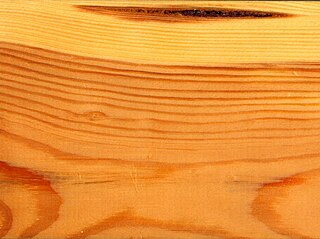
Softwood is wood from gymnosperm trees such as conifers, as well as Amborella. The term is opposed to hardwood, which is the wood from angiosperm trees.

Picea mariana, the black spruce, is a North American species of spruce tree in the pine family. It is widespread across Canada, found in all 10 provinces and all 3 Arctic territories. Its range extends into northern parts of the United States: in Alaska, the Great Lakes region, and the upper Northeast. It is a frequent part of the biome known as taiga or boreal forest.
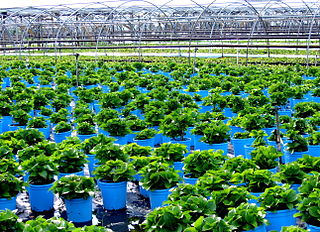
A nursery is a place where plants are propagated and grown to a desired age. They include retail nurseries which sell to the general public, wholesale nurseries which sell only to businesses such as other nurseries and to commercial gardeners, and private nurseries which supply the needs of institutions or private estates.
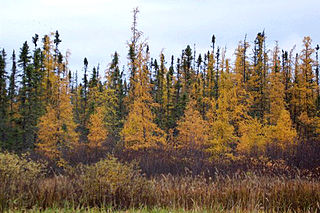
Larix laricina, commonly known as the tamarack, hackmatack, eastern larch, black larch, red larch, or American larch, is a species of larch native to Canada, from eastern Yukon and Inuvik, Northwest Territories east to Newfoundland, and also south into the upper northeastern United States from Minnesota to Cranesville Swamp, West Virginia; there is also an isolated population in central Alaska. The word akemantak is an Algonquian name for the species and means "wood used for snowshoes".
Silviculture is the practice of controlling the growth, composition/structure, and quality of forests to meet values and needs, specifically timber production.

Picea rubens, commonly known as red spruce, is a species of spruce native to eastern North America, ranging from eastern Quebec and Nova Scotia, west to the Adirondack Mountains and south through New England along the Appalachians to western North Carolina. This species is also known as yellow spruce, West Virginia spruce, eastern spruce, and he-balsam.

Picea glauca, the white spruce, is a species of spruce native to the northern temperate and boreal forests in North America. Picea glauca was originally native from central Alaska all through the east, across southern/central Canada to the Avalon Peninsula in Newfoundland. It now has become naturalized southward into the far northern United States border states like Montana, Minnesota, Wisconsin, Michigan, Vermont, New Hampshire and Maine; there is also an isolated population in the Black Hills of South Dakota and Wyoming. It is also known as Canadian spruce, skunk spruce, cat spruce, Black Hills spruce, western white spruce, Alberta white spruce, and Porsild spruce.

Choristoneura fumiferana, the eastern spruce budworm, is a species of moth of the family Tortricidae. It is also commonly referred to as the spruce budworm. It is one of the most destructive native insects in the northern spruce and fir forests of the eastern United States and Canada. Its range is also the widest of all the budworm species. Eastern spruce budworm populations can experience significant oscillations. During outbreaks, populations grow to extremely high densities, compared to the relatively low levels that occur in between. These outbreaks are highly destructive and can cause both economic and ecological damage. As a result, methods of control are utilized. Several theories exist regarding these cyclical outbreaks: association with balsam fir maturation, catastrophe theory, dispersal from an epicenter, and oscillations synchronized by entrainment.
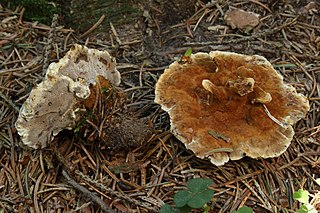
Onnia tomentosa is a species of fungus in the family Hymenochaetaceae commonly known as the woolly velvet polypore. It is frequently found in coniferous forests at higher altitudes, often growing in large groups, rather rare at lower altitudes. It is a plant pathogen, and causes tomentosus root rot, primarily in spruce. It was formerly known as Inonotus tomentosum (Fr.) Teng until molecular phylogenetic analysis led to major revisions in the classification of the Hymenochaetaceae.
Site index is a term used in forestry to describe the potential for forest trees to grow at a particular location or "site". Site is defined as "The average age of dominate and/or codominate trees of an even-aged, undisturbed site of intolerant trees at a base age"; furthermore, the word site is used in forestry to refer to a distinct area where trees are found. Site index is used to measure the productivity of the site and the management options for that site and reports the height of dominant and co-dominant trees in a stand at a base age such as 25, 50 and 100 years. For example, a red oak with an age of 50 years and a height of 70 feet (21 m) will have a site index of 70. Site index is species specific. Common methods used to determine site index are based on tree height, plant composition and the use of soil maps.

Canada's boreal forest is a vast region comprising about one third of the circumpolar boreal forest that rings the Northern Hemisphere, mostly north of the 50th parallel. Other countries with boreal forest, include Russia, which contains the majority, the United States in its northern most state of Alaska, and the Scandinavian or Northern European countries. In Europe, the entire boreal forest is referred to as taiga, not just the northern fringe where it thins out near the tree line. The boreal region in Canada covers almost 60% of the country's land area. The Canadian boreal region spans the landscape from the most easterly part of the province of Newfoundland and Labrador to the border between the far northern Yukon and Alaska. The area is dominated by coniferous forests, particularly spruce, interspersed with vast wetlands, mostly bogs and fens. The boreal region of Canada includes eight ecozones. While the biodiversity of regions varies, each ecozone has a characteristic native flora and fauna.
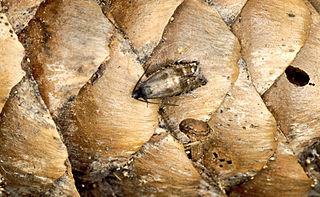
Cydia strobilella, the spruce seed moth, is a moth of the family Tortricidae. It is found in Europe.

Dendroctonus rufipennis, the spruce beetle, is a species of bark beetle native to British Columbia, Newfoundland and Labrador, Nova Scotia, Ontario, Quebec, Northern Manitoba, the Yukon, Colorado, Wyoming, Montana, and Maine. They are known to destroy forests of spruce trees including Engelmann, White, Sitka, and Colorado blue spruce. Adults average 4 to 7 mm in length.

Dioryctria reniculelloides, the spruce coneworm, is a species of moth of the family Pyralidae. It is found from Nova Scotia to Alaska, south in the east to New York, and south in the west to California and New Mexico. It was recorded from China in 2009. Occasionally abundant, often in conjunction with epidemics of the spruce budworm, the spruce coneworm occurs through most or all of the range of spruce in North America, feeding on new foliage and cones of spruce, and often balsam fir. When abundant, it can be a serious pest "particularly on white spruce".

Megastigmus atedius is a species of minute wasp that feeds on white spruce seed and cones. The damage it causes is largely undetected because the larvae complete their development hidden inside the seeds, which reveal no external indication of this. Although species of Megastigmus are said to be host-specific, the spruce seed chalcid found near Fairbanks, Alaska, was identified by E.H. Holsten and others in 1980 as M. piceae, while A.H. Rose and O.H. Lindquist applied the name Megastigmus piceae, but gave the authority as Rohwer.
The spruce cone rust, caused by the rust fungus Chrysomyxa pirolata Wint., affects spruces in 3 continents, including white spruce in Canada. Alternate hosts of the fungus are several species among 3 genera of wintergreen: Pyrola spp., Orthilia spp., and Moneses spp.. Diseased cones open prematurely and orange-yellow aeciospores are sometimes produced in such quantity as to color the forest floor and lake surfaces. Up to half of a cone crop can be affected, and most of the affected cones do not produce viable seed. Some localities commonly experience damage to 20% to 30% of cone crops, a factor to be considered in the siting of seed orchards.
Spruce sawflies are various sawfly species found in North America that attack spruce. There are multiple species of sawflies, including, European spruce sawfly, yellow-headed spruce sawfly, green-headed spruce sawfly, little spruce sawfly, and spruce webspinning sawfly. Each kind of sawfly attack particular parts of the spruce during different times of the year. These insects first begin feasting, or attacking, spruce as [larvae] and continue until they are fully grown.
References
- ↑ Hedlin, A.F.; Yates, H.O.; Tovar, D.C.; Ebel, B.H.; Koerber, T.W.; Merkel, E.P. 1980. Cone and seed insects of North American conifers. Can. For. Serv./USDA For. Serv./Secretaría Agric. Recursos Hidráulicos, Mexico. 122 p. [A publication instigated at the 10th meeting of the Study Group on Forest Insects and Diseases, North American Forestry Commission, FAO, held in Canada in 1974]
- ↑ Syme, P.D.; Nystrom, K.L. 1988. Insects and mites associated with Ontario forests: Classification, common names, main hosts and importance. Canadian Forestry Service, Great Lakes Forestry Centre, Sault Ste Marie, Ontario. Information Report O-X-392. 131 p.
| This Olethreutinae-related article is a stub. You can help Wikipedia by expanding it. |